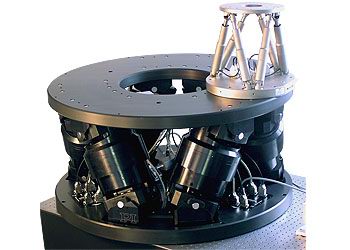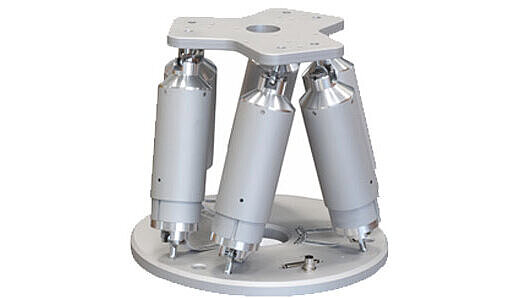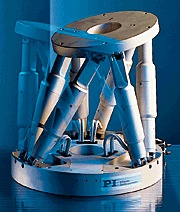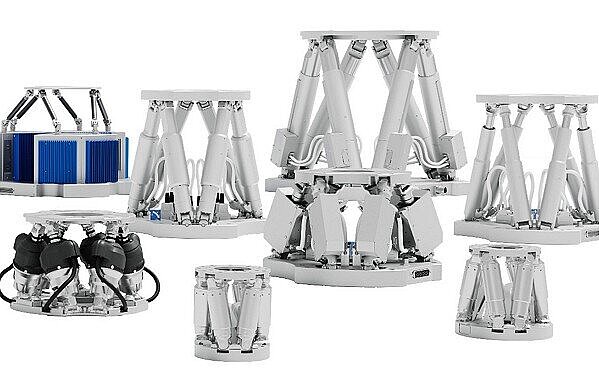Hexapod for Very High Loads
Custom 6-Axis Parallel-Kinematics System for 1000kg Load (M-850k102 Hexapod)
PI has designed a unique Hexapod (Stewart Platform) high-load 6-axis stage for astronomy applications and other alignment tasks. The M-850K102 custom Hexapod stage combines extremely high precision with a load capacity of up to 1000 kg. It provides minimum incremental motion to 0.8 µm and 1 µrad, respectively. The six individual actuators have a design resolution of 0.08 µm and a stiffness of 40 N/µm.
- Six Degrees of Freedom
- Works in Any Orientation
- No Moving Cables for Improved Reliability and Precision
- 1000 kg Load Capacity (Vertical)
- Heavy-Duty, Ultra-High-Resolution Bearings for 24/7 Applications
- Repeatability to 0.5 µm
- Actuator Resolution 0.008 µm
- Significantly Smaller and Stiffer Package than Conventional Multi-Axis Positioners
- Vacuum-Compatible Versions
- Linear and Rotary Multi-Axis Scans
- Virtualized Center of Rotation (Pivot Point)
- Sophisticated motion controller Using Vector Algorithms
Hexapod Working Principle and Advantages
The M-850 Stewart Platform Hexapod is driven by six high-resolution actuators all connected directly to the same moving platform. The principle is similar to that seen in flight simulators, but considerably more precise. In place of the hydraulic actuators used there, the M-850 hexapod stage uses custom high-load precision screws and servo-motors. It can withstand loads of 1000 kg vertically, and at least 180 kg in any direction.
Technical Specifications:
Number of Axes: | 6 |
Linear travel range XYZ: | 24 mm |
Rotation range: | 8 deg. (rot z) 6 deg. (rot x, y) |
Actuator design resolution: | < 0.08 µm |
Minimum incremental motion XYZ: | 0.8 µm |
Minimum incremental motion Rot xyz: | 1 µrad |
Repeatability X, Y: | 1 µm |
Repeatability Z: | 0.5 µm |
Max Linear Velocity XYZ: | 0.5 mm/s |
Max Rotary Velocity: | 6 mrad/s |
Actuator Stiffness: | 40 N / µm |
Load capacity: | up to 1000 kg (depends on orientation) |
Weight: | 450 kg |
Typical Applications
Alignment and tracking of optics, electron beams; fine positioning of active secondary mirror platforms in astronomical telescopes






